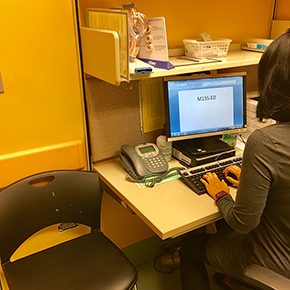M155.ED: Seen and Left Without Being Seen
 The physician’s note about Ms. Z was nothing unusual:
The physician’s note about Ms. Z was nothing unusual:
Patient exam is relatively benign. Patient non-adherent with appointments and follow-up.
Declines more reliable forms of birth control today- offered IUD and Depo. Patient wants tubal ligation, though also given information regarding vasectomy for partner.
And that was the problem.
Last week, I wrote about our clinic’s efforts to avoid diagnoses of “Left Without Being Seen.” Ms. Z had a clinical visit, but she still left without “being seen”. For these situations, I have created a new diagnosis code: M155.ED: seen and left without being seen.
The clinical team that initially saw her was correct. She missed her appointments. And definitely didn’t consistently take her medications. And after years of unplanned pregnancies that resulted in both continuations and terminations, she had had it- she wanted a tubal ligation. But the language used to describe Ms. Z masks the possibilities of why.
Does the reason for a person’s contraception choice matter? It does if we take the time to document the suggestions we offered, without documenting the reason why someone declines. Does the reason for missed appointments or medications matter? It does if we take the time to document that someone is “non-adherent”, without documenting the reason why they are missed.
What I happened to know (because of her referral to PurpLE Clinic by her lawyer), that her previous care team did not, was that at the time of her visit, Ms. Z was in the midst of leaving her abusive husband. Sexual assault occurs in marriages, and it was occurring in Ms. Z’s. She was consistently raped by her husband, being forced to have sex with him when she did not want to. And while well intentioned, the option of vasectomy was a non-starter in her situation (as it likely would be for women experiencing interpersonal violence, whose situations are void of negotiation power.)
We don’t know if Ms. Z declined depo because she couldn’t make follow-up appointments- her husband had threatened her regarding contraception use (reproductive coercion is a form of control by abusers) or if she, like many other women, simply did not like certain methods of contraception. We don’t know if Ms. Z missed her medications and appointments due to her limited allowance (dispersed to her weekly by her husband), forcing her to ration her funds among her essential needs: transportation, medication, food, childcare while going to see her lawyer and phone access, among others.
The clinical team could not have known all of these things. But the unintended impact of their inclusions and omissions lives on in the medical charts of our patients, with far-reaching consequences- particularly for those who are already vulnerable to poor healthcare. Maybe Ms. Z’s other doctors review her chart and make incorrect assumptions about her “no shows” or commitment to her health given her declining of “more reliable forms of birth control”, further marginalizing her care. Maybe the medical student reviews the attending’s note, and learns that missed appointments or “non-adherence” are assessments of a person, instead of symptoms that deserve further exploration.
I cringe sometimes when I look back at old notes I had written. They are time-stamped evidence of my assumptions and useless recommendations- riddled with M155.ED diagnosis codes. I no longer falsely reassure myself that if I became aware of one sensitive event in a person’s life (perhaps trafficking, perhaps a suicide attempt), that this was a sign that people would always feel comfortable disclosing other issues of trauma, stigma or shame affecting their health. Even in a clinic designed for survivors of sexual trauma, I learn from other members of our team, such as our care navigator, that there are issues affecting patients’ health that they sometimes felt too ashamed to discuss with me. I know that “I don’t know what I don’t know.”
So what can I do about this? These experiences have changed the language I use when documenting in patient charts. At a time when the concepts of reproductive justice, social determinants of health and trauma-informed care are raised in provider consciousness, how we choose to document a clinical encounter is an innate reflection of our understanding of these critical issues. When I document, I force myself to justify why I am including certain information, and double-checking what I leave out. If I say “patient declined”- I include why. Most of the PurpLE Clinic patients I see have missed appointments. I don’t remark on this, unless it connects to a reason that we have discussed together, and is something I can potentially address (like not having subway fare.) With each note, I try to be conscientious of the message I may be unintentionally communicating to the patient’s future care team, and the behavior I am modeling to learners about clinical documentation.
Z53.21 diagnosis codes can be avoided but M155.ED diagnosis codes are inevitable. The good news is, deliberate, iterative efforts for respectful documentation can decrease the collateral damage of M155.ED diagnoses and potentiate the necessary culture of change in healthcare delivery for survivors of sexual violence.
As I wrap up on this RHAP collaboration for sexual assault awareness month, I hope that the lessons I’ve learned from patient patients will be useful for you and your learners as well.
Thank you for taking the time to read this. Your feedback, comments and questions are very welcome: Anita.Ravi@aya.yale.edu
*Note: Ms. Z is a fictional composite of several different clinical experiences
